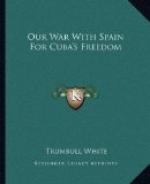The foreign warships in the bay were notified of the attack, all of them withdrawing out of range. The English and Japanese warships joined the American fleet off Cavite, and the French and German warships steamed to the north of the city, where they were out of range.
The attack was arranged for the 9th inst, but at the last minute General Merritt requested that the fleet postpone the bombardment until his lines could be extended farther around the city. Then Admiral Dewey informed the Spaniards that the attack would be made on Saturday; that he would destroy Fort Malate and shell the trenches, thus destroying the opposition to the land forces entering the city; that he would not fire on Manila unless their guns opened on his ships, in which case he would destroy the city.
At 9 o’clock on the morning of Saturday the American fleet, with battle flags flying at every masthead, left Cavite, the band on the British warship Immortalite playing “El Capitan” at the departure.
The agreement between Dewey and Merritt was to get under way with the fleet standing toward the city at the same time the troops pressed forward ready to force an entrance when the ships had destroyed the forts.
With the fleet the Olympia led the way, attended by the Raleigh and the Petrel, while the Calloa under Lieutenant Tappan and the launch Barcolo crept close inshore in the heavy breakers.
Perfect quiet prevailed in the lines on both sides as the great ships, cleared for action, silently advanced, sometimes hidden by rain squalls. The Monterey, with the Baltimore, Charleston and Boston, formed the reserve.
At 9:35 a sudden cloud of smoke, green and white against the stormy sky, completely hid the Olympia, a shell screamed across two miles of turbulent water and burst near the Spanish fort at Milate San Antonio de Abad. Then the Petrel and Raleigh and the active little Calloa opened a rapid fire directed toward the shore end of the intrenchments. In the heavy rain it was difficult to judge the range, and the shots at first fell short, but the fire soon became accurate and shells rendered the fort untenable, while the four guns of the Utah battery made excellent practice of the earthworks and swamp to the east of the fort. The Spaniards replied with a few shells.
Less than half an hour after the bombardment began General Greene decided that it was possible to advance, although the signals to cease firing were disregarded by the fleet, being invisible on account of the rain. Thereupon six companies of the Colorado regiment leaped over their breastworks, dashed into the swamp and began volley firing from the partial shelter of low hedges within 300 yards of the Spanish lines. A few moments later the remaining six companies moved along the seashore, somewhat covered by a sand ridge formed by an inlet under the outworks of the fort, and at 11 o’clock occupied this formidable stronghold without loss.




